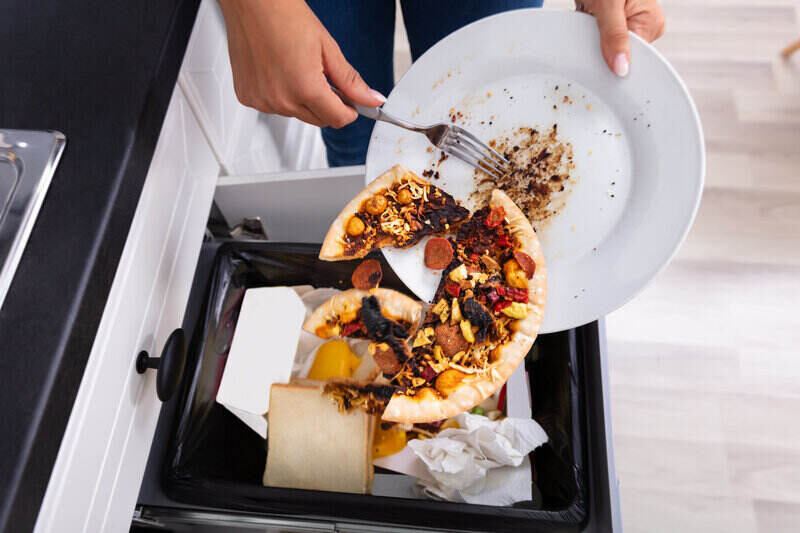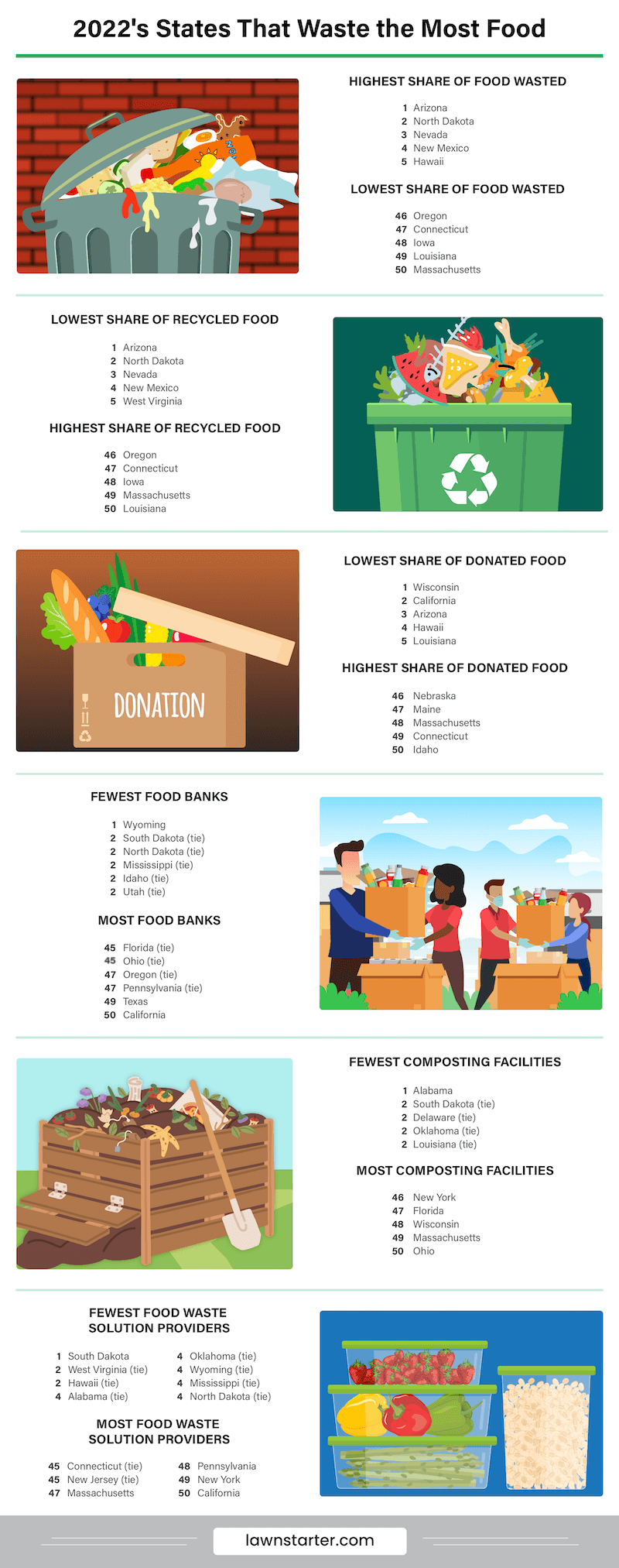
No matter how much turkey you gobble up this Thanksgiving, more food could end up in the trash instead of your belly, depending on where you live.
About 30–40% of the national food supply goes to waste each year, 200 million pounds of which comes from Thanksgiving turkeys alone. But some states contribute more to that total than others.
Ahead of one of the tastiest (and waste-iest) holidays, LawnStarter ranked 2022’s States That Waste the Most Food.
We compared the 50 states based on how much food they waste, how much they repurpose, and what measures they have in place to reduce food loss.
Check out our ranking below, followed by some highlights, lowlights, and some food for thought on how you can reduce food waste. Your grocery budget and the local landfill (still stuffed from last Turkey Day) will thank you.
Table of Contents
State Rankings
See how each state fared in our ranking:
| Overall Rank (1 = Most Wasteful) | State | Overall Score | Food Wasted Rank | Repurposed Food Waste Rank | Food Waste Mitigation Efforts Rank |
|---|---|---|---|---|---|
| 1 | Arizona | 82.91 | 4 | 1 | 17 |
| 2 | North Dakota | 78.13 | 12 | 3 | 8 |
| 3 | Hawaii | 77.54 | 16 | 2 | 12 |
| 4 | Nevada | 77.12 | 11 | 7 | 7 |
| 5 | Oklahoma | 76.68 | 15 | 6 | 6 |
| 6 | West Virginia | 75.79 | 19 | 8 | 4 |
| 7 | Wisconsin | 75.73 | 5 | 4 | 24 |
| 8 | Georgia | 74.90 | 6 | 13 | 20 |
| 9 | Montana | 74.33 | 25 | 9 | 10 |
| 10 | South Dakota | 74.00 | 33 | 10 | 1 |
| 11 | South Carolina | 72.77 | 21 | 16 | 9 |
| 12 | Wyoming | 72.75 | 31 | 12 | 2 |
| 13 | Mississippi | 72.50 | 29 | 15 | 3 |
| 14 | North Carolina | 72.35 | 8 | 17 | 23 |
| 15 | Kentucky | 70.96 | 26 | 22 | 15 |
| 16 | New Hampshire | 70.94 | 32 | 19 | 14 |
| 17 | Missouri | 70.50 | 30 | 20 | 18 |
| 18 | New Mexico | 70.18 | 14 | 5 | 27 |
| 19 | Delaware | 69.59 | 38 | 24 | 5 |
| 20 | Tennessee | 68.84 | 34 | 33 | 16 |
| 21 | Alaska | 68.51 | 41 | 27 | 11 |
| 22 | New Jersey | 68.27 | 24 | 34 | 21 |
| 23 | Utah | 67.20 | 22 | 11 | 26 |
| 24 | Virginia | 66.45 | 9 | 18 | 33 |
| 25 | Florida | 66.40 | 2 | 38 | 39 |
| 26 | Maryland | 64.46 | 20 | 23 | 32 |
| 27 | Colorado | 64.40 | 23 | 35 | 25 |
| 28 | Alabama | 64.02 | 28 | 26 | 29 |
| 29 | Michigan | 63.77 | 10 | 21 | 40 |
| 30 | Nebraska | 63.18 | 44 | 41 | 13 |
| 31 | Indiana | 62.69 | 27 | 25 | 36 |
| 32 | Rhode Island | 61.85 | 37 | 14 | 38 |
| 33 | Minnesota | 61.81 | 36 | 28 | 34 |
| 34 | Texas | 61.43 | 3 | 46 | 41 |
| 35 | Arkansas | 61.19 | 39 | 31 | 30 |
| 36 | Kansas | 60.10 | 40 | 30 | 35 |
| 37 | Pennsylvania | 59.79 | 18 | 36 | 42 |
| 38 | Ohio | 59.68 | 13 | 32 | 43 |
| 39 | Idaho | 58.65 | 42 | 48 | 19 |
| 40 | Maine | 57.65 | 43 | 40 | 31 |
| 41 | Illinois | 57.16 | 35 | 42 | 37 |
| 42 | California | 56.80 | 1 | 49 | 50 |
| 43 | New York | 55.83 | 7 | 29 | 47 |
| 44 | Iowa | 55.32 | 50 | 45 | 22 |
| 45 | Washington | 54.33 | 17 | 37 | 45 |
| 46 | Louisiana | 52.29 | 49 | 43 | 28 |
| 47 | Vermont | 48.17 | 46 | 39 | 44 |
| 48 | Oregon | 41.06 | 45 | 44 | 48 |
| 49 | Connecticut | 39.46 | 47 | 47 | 46 |
| 50 | Massachusetts | 33.33 | 48 | 50 | 49 |

Highlights and Lowlights
Wasting Arizona
Arizona is our No. 1 state that wastes the most food for a cornucopia of reasons. Among the 50 states, the Grand Canyon State registered the highest share of food wasted and the lowest share recycled. It also ranked No. 3 for the lowest share of food donated to people in need.
Some Arizonans are doing their best to minimize food loss, though. The state has more organizations providing food waste solutions than over half the country. Imperial Western Products (IWP) diverts the most food waste from landfills in Arizona. The company saves about 1.23 million tons of food waste annually by recycling and reusing materials from agricultural sites, restaurants, and bakeries.
Local tip: This year after Thanksgiving dinner, follow IWP’s lead and find a way to recycle your green bean casserole (Arizona’s favorite side dish) into leftover meals, or donate it instead of adding on to Arizona’s already grand food waste problem.
Alo-high Food Prices in Hawaii
Because most food is imported from the mainland, Hawaiians pay the highest average cost of food in America: over $200 more per month than the national average. You’d think the extra cost would result in less food waste, but Hawaii ranked No. 3 on our list of States That Waste the Most Food.
Why? Hawaii lacks the infrastructure to support food waste reduction, for one. It also has no bans on industrial food waste disposal and no statewide food sharing program. Plus, there are very few organizations offering food waste solutions.
Tourism presents another problem. Visitors tend to splurge on food more than locals, and their eyes are often bigger than their appetites. About 40% of Hawaii’s seafood and half of its fresh fruit, two of the island’s most popular commodities, end up in the trash every year, while one in five native households are living with food insecurity.
Sin City Strikes Again
Las Vegas is famous for its buffets, but where does all that leftover food go? Most of it ends up in the nearby Apex Regional Landfill, one of the largest landfills in the world. With Vegas alone producing thousands of tons of food waste every year, it’s no wonder Nevada ranked No. 4 overall among States That Waste the Most Food.
However, many resorts on the Strip are working toward a less wasteful future. They’re using leftover food to make compost, donating it to food banks, and even sending it off to feed pigs. A few years from now, Nevada just might fall further down on our list.
For now, The Silver State still leaves most of its uneaten food to waste away in landfills. Nevada ranks No. 11 out of 50 for food wasted and No. 7 for the least food waste being repurposed.
Mass-ive Food Waste Reduction
Massachusetts wastes the least food. Across the board, the Bay State is a pioneer of reducing food waste. Massachusetts residents and businesses throw out less food than all but two states and either recycle or donate more food than any other state. (Massachusetts is No. 50 in the Repurposed Food Waste category.)
On top of individual efforts, the state itself supports food waste mitigation with such measures as the Commercial Food Material Disposal Ban and a higher-than-average number of composting facilities.
Local tip: Massachusetts may have fallen to the bottom of our list, but in this case, that’s a good thing! Don your best “EcoFashion” outfit and celebrate this win for the environment at next year’s Boston GreenFest.
Ask The Experts
Changing your personal habits is important for solving the food waste problem in the United States, but real progress comes from communities working together. We asked some experts in the field for tips to help you reduce your personal food waste and inspire others in your community to do the same.
- Why do Americans waste nearly 40% of all food?
- What is the single most important change an individual can make to cut back on their personal food waste?
- What are the best foods to buy to minimize food waste?
- What are the three best ways to reduce food waste on a community level?
- How can average Americans establish food sharing programs, food banks, composting facilities, or other food waste reduction programs in their communities?



Why do Americans waste nearly 40% of all food?
Americans collectively waste about 40% of nutritious and edible food across the food system. Food is wasted when it is being produced, distributed, processed, prepared and sold — all before it reaches the consumer.
People that work in food sectors around farming, manufacturing, distributing, stocking, and selling can all help to improve systems to decrease the amount of food that is lost in the supply chain.
Food is also wasted after the consumer brings it home. After food is in their hands, consumers have a lot of responsibility to make sure food that is nutritious and edible is not thrown away and they can do that by planning meals, shopping responsibly, and preparing and preserving food so that it does not go to waste.
What is the single most important change an individual can make to cut back on their personal food waste?
Planning meals and having a shopping list before purchasing groceries reduces the amount of extra food in a household. Unnecessary purchases can lead to food waste because the food expires and needs to be thrown away because it is no longer safe to eat.
Breaking down the process into small steps is the easiest way to approach meal planning.
First, set aside 30 minutes to an hour weekly on the calendar to meal plan.
Second, select the main recipes for the coming week. Make sure to modify the recipe size so that there is enough for everyone and to account for leftovers if desired.
Third, prepare a shopping list that includes ingredients needed to complete the recipes.
Lastly, make sure to stick to your meal plan throughout the week. If life gets in the way, shift the calendar to prepare meals with ingredients that expire quickly.
Plan meals ahead of time so that a leftover can be used in a new dish. For example, broccoli can be consumed as a side dish one night and be used in a penne pasta dish the next night.
Leftovers are always an easy and comforting option for lunch the next day. If a person does not enjoy eating leftovers, plan meal sizes to suit the needs of those eating it by modifying a recipe.
What are the best foods to buy to minimize food waste?
If you do not have time to plan and prepare meals, focus on buying foods that don’t go to waste as quickly and are healthy at the same time. Root vegetables and fruits that store well, like apples, keep for several weeks if stored properly. When a person purchases fruits and vegetables that go bad quickly, eat them first.
If a fruit or vegetable is ripening but a person is not ready to eat it, learn ways to preserve it such as canning, freezing, drying, pickling, or fermenting. Overripe fruits and vegetables can be a delicious addition to soups and smoothies. Purchase other foods that freeze or store well, but watch out for additives that preserve food so that your diet is nutritious at the same time.
Many tools can help us to reduce food waste such as a blender to make smoothies, a crock pot to make soup, containers that seal well so that food can be stored longer. There are many meal planning apps available to make this important weekly task easier.
One of the best practices we can use is mindfulness to pause and think about alternative ideas before throwing food away.
What are the three best ways to reduce food waste on a community level?
- Normalize “ugly” fruits and vegetables or other fresh foods. Typically, the consumer expects fruits, vegetables, and other fresh foods to be a certain shape or color. Accepting the fact that all of these foods that do not look “perfect” are perfectly edible and nutritious, will reduce food waste substantially.
- Focus on donating healthy foods to food sharing programs, food banks, and other forms of nutrition assistance. Many times, individuals focus on donating shelf stable foods that have a lot of additives, which are not necessarily healthy to the individual receiving the food.
Consumers and food retailers should set up strategies to donate foods that promote the health of people receiving the donated foods, especially since much of the food that is wasted is fresh. - Build and invest in technology to connect people to food that might be wasted. Technology, if used on a wide scale, can help communities to report and distribute food that would otherwise go to waste.
How can average Americans establish food sharing programs, food banks, composting facilities, or other food waste reduction programs in their communities?
Get involved locally. There are many people thinking about the issue of food waste in communities because it impacts everyone from city government to food retailers to food assistance.
Ask what programs are happening and how you can be a part in reducing waste in your community. If no one is doing anything about the problem of food waste locally, build a team of people to assess the scale of the issue, determine potential solutions, and then get to work!

What is the single most important change an individual can make to cut back on their personal food waste?
One thing I always preach with my students is the idea of mindful cooking to reduce waste. We all know about mindful eating, but you can also cook in a way where you continually ask yourself, ‘What can I do with this product before it goes into the compost or trash?”
Using that framework, our students have developed amazing dishes with cauliflower rice made from the core, broccoli stalk stir-fries, cream soups, and so on. There is even a new beverage on the market that our former students developed made from avocado seeds.
Methodology
We ranked the 50 states from most wasteful (No. 1) to least wasteful (No. 50) based on their overall scores (out of 100 possible points), averaged across all the weighted metrics listed below.
| Metric | Weighting | Min. Value | Max. Value | Best |
|---|---|---|---|---|
| Food Wasted | ||||
| Share of Wasted Food (Out of Total Food Surplus) | 4 | 47.39% | 78.52% | Min. Value |
| Quantity of Wasted Food (Tons) | 3 | 71,259.80 | 10.4 Million | Min. Value |
| Value of Surplus Food | 2 | $677.2 Million | $51.7 Billion | Min. Value |
| Repurposed Food Waste | ||||
| Share of Recycled Food | 3 | 18.69% | 49.27% | Max. Value |
| Quantity of Recycled Food (Tons) | 2 | 27,945.97 | 3.9 Million | Max. Value |
| Share of Donated Food | 4 | 2.58% | 6.07% | Max. Value |
| Quantity of Donated Food (Tons) | 3 | 4,186.42 | 404,882.62 | Max. Value |
| Food Waste Mitigation Efforts | ||||
| Presence of Food Waste Disposal Bans (1 = Present, 0 = None Present) | 3 | 0 | 1 | Max. Value |
| Presence of Food Sharing Program (1 = Present, 0 = None Present) | 2 | 0 | 1 | Max. Value |
| Share of Households with Residential Food Collection Programs | 2 | 0.00% | 58.76% | Max. Value |
| Number of Food Banks | 1 | 0 | 35 | Max. Value |
| Number of Composting Facilities | 1 | 0 | 374 | Max. Value |
| Number of Anaerobic Digestion Facilities | 1 | 1 | 201 | Max. Value |
| Number of Food Waste Solution Providers | 1 | 2 | 59 | Max. Value |
Sources: Food Rescue US, ReFED, U.S. Environmental Protection Agency, and US Composting Council
Why and How to Reduce Food Waste
Why do some states make such an effort to reduce their food waste? Here’s one reason: Food waste in landfills produces about 3.3 billion tons of carbon dioxide every year. Carbon dioxide is the main greenhouse gas responsible for global warming.
If saving the planet isn’t enough of a reason to reduce your food waste, how about saving money? The average American spends around $3.62 per day on food that never gets eaten. That adds up to more than $100 per month and more than $1,300 per year.
With just one year of food waste savings, you could fill your car with gas 20 or 30 times (depending on where you live) — or spend 1.5 weeks at Disney World.
Whether you’re an eco-warrior or a thrifty spender, here are a few tips to help you reduce your personal food waste:
- Plan ahead. Before hitting the grocery store, think about how many meals you’ll need to make at home for the week. Plan different dishes that use some of the same ingredients to minimize waste.
- Buy frozen or canned. Fruits and vegetables make up about 30% of food waste in the U.S. because they spoil so quickly. Frozen or canned fruits and veggies are just as nutritious as fresh produce, and they last much longer!
- Freeze perishable items. Bread, meat, fruits, vegetables, and other perishables often go bad before you have a chance to eat them. If you know you won’t finish them in the next few days, store perishable items in the freezer for a longer shelf life. Wash, dry, and slice or chop fruits and veggies before freezing them.
- Eat leftovers. Whether you’re at home or at a restaurant, save any food you don’t eat for later. If you don’t want to eat the same thing again, look up recipes online for ways to transform your leftovers into something new.
- Compost food waste. Even when you give it your best effort, you’ll end up with some food scraps. Instead of sending them off to a landfill, start a compost pile in your backyard. Composting is a 2-for-1 deal: You recycle your food waste, and you can use the compost for your garden or potted plants. (Make sure to check composting rules beforehand.)
So, try squeezing a few more meals out of those Thanksgiving leftovers. Maybe mix it up with one of Food Network’s out-of-the-sandwich-box recipes made with America’s favorite Turkey Day dishes. It’s the “green” thing to do — for the environment and your wallet.
Speaking of green, LawnStarter’s local pros can keep your lawn green and healthy while you stay inside and enjoy a turkey nap.
Main photo credit: Shutterstock